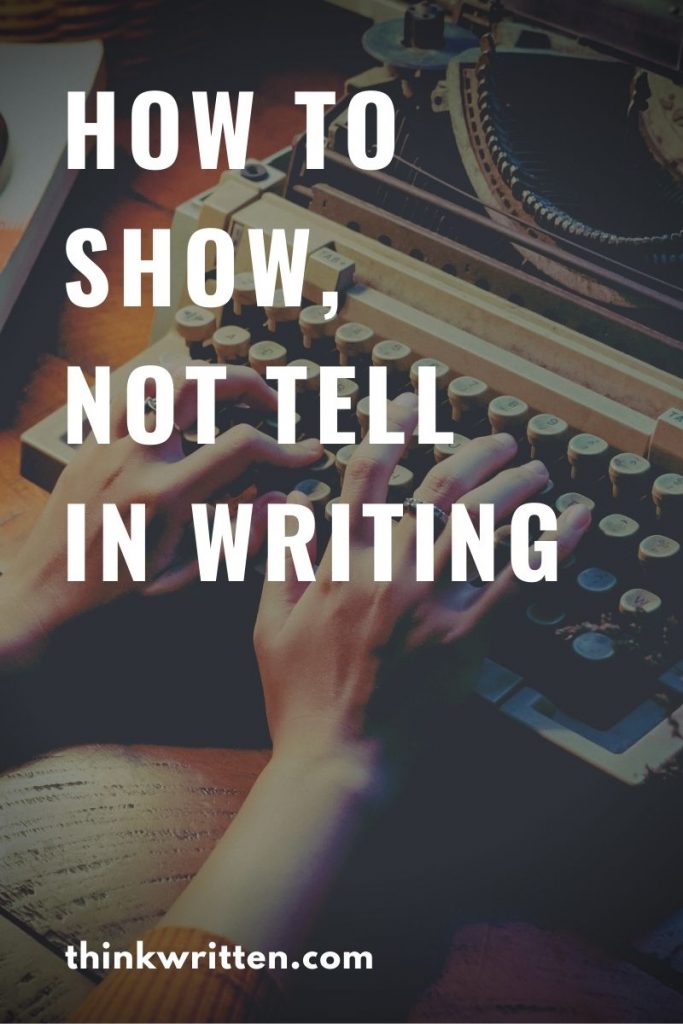We may receive a commission when you make a purchase from one of our links for products and services we recommend. As an Amazon Associate we earn from qualifying purchases. Thank you for support!
Have you ever heard you should “show and not tell” when writing? In today’s post we’ll explain exactly what that means and share some tips to help you master the art of “show don’t tell” in your writing.

One of our primary urges as humans, and especially as writers with a story to tell, is to be understood by those with whom we communicate. We want, above all else, to be received and to have our stories received as complete with our own intent as possible.
Our audiences, whomever they may be, are as vital to us as writers as the characters that inhabit our stories, real or fiction. There exists, however, a line that defines the boundary between telling the story and telling your reader what is happening.
What Does Show and Don’t Tell Mean?
In writing, the term “show don’t tell” means to write in a way that allows your audience to fully experience the setting, characters and action in the story. As a writer, it’s important for you to not merely state facts but to connect with your audience and draw them into the story.
Imagine you are in a car being driven along a scenic highway. It winds through mountains and valleys, forests of trees and meadows of glorious flowers, pastoral farmlands and quaint village streets lined with unique old homes and storefronts decorated for the holidays.
I haven’t provided a lot of description, but you get the general idea. There are a lot of sights to see and experiences to take in.
Now, imagine you’re being driven through this majestic landscape in the back of a box truck with no windows, and the driver is telling you what you pass when you pass it.
In this instance, you can’t see what is going on. You only hear the driver describing what is going on around you. Sure, you might have a good idea of what is going on around you, but you’re missing out on a big, enjoyable piece of the experience.
It is the same for us when writing – telling instead of showing deprives the audience of something vital to the work itself. This is why it is important as writers of fiction and expository non-fiction that we not sacrifice art for expedient clarity, because that is why our readers come to us – for that experience. That is why it’s important to know when it’s okay to tell and when it is better to show the reader instead.

What’s the difference between showing and telling?
“Bill,” you say, “isn’t all writing just telling? I mean, we’re telling a story, right?”
The answer is yes – and no.
Stephen King, in his memoir On Writing, describes the connection between writer and reader as a form of telepathy – a way for two individuals to share thoughts, ideas, stories, and images across space and time.
Our job as writers is to build the space in which we share thoughts and stories with the audience. Like good architects, we don’t build with the expectation that we will have to explain every ogive and buttress to the reader in explicit detail. Some parts of what we build are there to be discovered.
In writing, this means displaying certain key traits of characters and settings in ways that the reader will understand but aren’t direct exposition. The key is in understanding what is okay to tell and what is better shown.
How to Show, Not Tell What You See
Let’s start with what it is okay to tell in your writing: Basic facts, colors of rooms, whether the curtains are opened or closed. File all that under “physical description of people, places, and things” and call it a day.
The mundane (but relevant) details of the world inside your text can be easily described in a manner described as “telling”.
The key to “showing and not telling” is to use your descriptive language in a way that it evokes a certain mood and tone. It clearly conveys how the character is feeling about a situation without ever coming right out and saying it.

Consider this example:
Jack stepped off the elevator and onto the fourth floor. Gray, shoulder-height cubicles stood in parallel sets up and down what was described to him as an “open office space”, with narrow, labyrinthine corridors bisecting the rows at odd intervals. Windows lined the outside walls of the building, though none of them were visible without standing to peek over the edge of one of the charcoal colored boxes, and the space between the outer rows and the panes of glass was barely wide enough for two adults to walk abreast.
Fluorescent lights blared down from the tiled ceiling, calling attention to several brown water stains. Aside from the low thrum of the air conditioning, the muted ringing of telephones, and the seemingly far-off drone of human voices, the place was eerily silent.
Jack could see the woman he was looking for carrying a bundle of papers close to her chest as she made quick, practiced movements through the cube farm towards its center where stood a raised platform, surrounded by low walls and plexiglas windows in aluminum frames. There were no straight lines that led to the dais, so he watched the woman and tried, best as he could, to plot a converging course.
I used to work in such a corporate hellscape, which is why describing it comes so naturally to me. This is pretty much straight descriptive narration, but you can probably tell how I feel about this sort of work environment through the use of certain words – blaring lights, inaccessible windows, that word labyrinthine evoking images of Minotaurs and inescapable dread, the dreary colors.
With this example, you know exactly what I am feeling about this space – but I never directly tell you, and I don’t need to. And that, dear reader, is the “show” part of the lesson – the intangible details and feeling surrounding a person, place, or thing, with an emphasis on feelings.
What You Feel
As writers, we should guide people towards ideas, but never spoon-feed the reader. Like in the film Inception, if the idea you are trying to put across doesn’t feel organic – if the reader doesn’t believe they came to it on their own – the brain/reader is likely to reject it.
Now, a reader might not reject the idea of a company cube farm being an oppressive work environment, but, if you come straight out and say it, they’re bound to get bored with your prose and leave the story behind for something more engrossing.
As an example, I could tell you about Jack, our character from the above excerpt, and his personality. However, it would be more effective to show you through his actions. Let’s continue this story and further illustrate showing and not telling.
“Excuse me, Ms. Singer?” Jack said as he stepped onto the dais in the center of the office. He could see the green tops of trees in the courtyard out the windows from where he stood now. There sat a table with a coffee pot steadily percolating and all the fixings one could want at the narrow entrance to center stage, and larger desks populated the crowded space.
The woman he’d been following distributed her papers among the desks, never breaking her quick-step pace. Jack produced his badge and stepped into her path. “It is Ms. Singer, isn’t it?”
She came to a sudden stop. Her lips drew taught across her face, brows furrowed; she sighed and shifted her weight. “Yes? How can I help you?” she asked.
Jack gave a thin smile, introduced himself, and put his badge away. “I’d like to ask you a few quick questions about your associate, Mr. Bonelli. He worked here with you, correct?”
She shifted her weight again from one heel to the other. “If you need to confirm employment records, I would recommend speaking with human resources. They’re on the first floor.” She moved to slip through beside him.
He moved to block her, hands raised just to his chest with the palms facing out. “Won’t take but five minutes of your time; I promise.”
“I really don’t have anything to say about Mr. Bonelli and I don’t have five minutes to spare,” she replied. “Now, if you’ll excuse me, I’m very busy.”
He cut her off. “If that’s the case, I’m going to ask you to stop by the precinct on your way home this evening so we can get these questions answered.”
She propped a fist on her hip as she replied. “Do you have a warrant? Subpoena?”
Jack shook his head. “No, ma’am. All the same –.”
Ms. Singer’s features went from a frown to a bright smile. “I have no interest in talking to the police about anything unless I have a lawyer present and the District Attorney issues a subpoena for my testimony. Now, if you’ll excuse me,” she said as she skirted past him on the inside, “I have more papers to pickup for this morning’s meeting before the executives get here,” she finished as she swept deftly through the narrow entrance and down the aisle, clipping the edge of the table at the entrance with the hem of her skirt.
Jack watched her another moment as she swept down the rows, not even looking at where she stepped. He took a deep breath and held it a moment, knowing full well he couldn’t compel the woman to give a statement. He started on his way back towards the elevator, stopping at the table with the coffee and fixings to pull it two inches closer to the entrance of the dais and ever so slightly into the pathway through the bullpen, then left the same way he came.
He stopped at human resources to confirm Mr. Bonelli’s employment history – and to ask if they kept a first aid kit in the office. Sure enough, they had one. He needed a bandage, he explained, for a hangnail that had gotten caught somewhere, and then passed his card to the attending HR specialist. “If you see Ms. Singer today,” he said, “give her this for me. Looks like we missed our chance to connect this morning. Hopefully I won’t miss her again.”
In this passage, we discover that Jack works for law enforcement, without ever directly saying that Jack is a police officer. We also get a peek into Jack’s personality in this passage.
While it is true that it takes longer to come to the conclusion that officer Jack can be a bit of a jerk (and a snarky one at that) this way than if we had just came straight out and said so, you can see the difference clearly in how the news is delivered.
If the author/narrator provides the reader with a piece of information directly, it doesn’t seem as valid. In order for you to accept it, you must discover it as the reader.
That discovery by the reader is what makes your writing genuine – the idea is clearly communicated through our channels of telepathy and received and accepted on the other side by the reader.
Always Have a Purpose While Writing
One thing to consider when showing or telling is this: it’s important to stick to details that are relevant to the story being told and to keep the showing actions of your characters within the scope of their personality.
Having a good idea of who your characters are is fundamental to building a believable narrative. Equally important is sticking to that scope of behaviors when writing for your characters.
Going back to our example, we might believe Jack may be a jerk, but he’s acting within the scope of his own morals. He is attempting to solve a crime and this person is obstructing his path towards that end.
In his mind, that justifies the small calamity he prepared that may (or may not) end up getting him the interview he needs. If this bit of his personality doesn’t jive with the rest of the story, or serve a purpose to further the narrative, then it doesn’t belong here. Never show (or tell) information about a character or setting without considering this first.
When you write with purpose, it’s easier to understand what details should be told and which ones are shown.
Showing and not telling in your writing can take a bit of practice to fully master. One of the best ways you can master this art is through the help of creative writing exercises. You can also try your hand at showing and not telling using many of our creative writing prompts.
How do you show and not tell in your writing? Share your struggles or tips in the comments section below!





